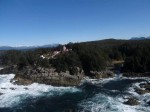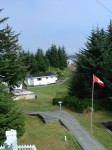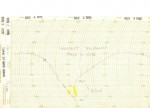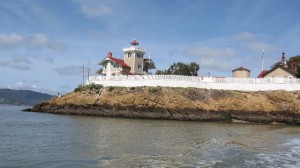– Reprinted courtesy of The Department of Fisheries and Oceans Canada

Cape Beale, . . . a lighthouse which later came to notice in a gallant and romantic rescue resulting from the actions of Mr. and Mrs. Paterson who kept the light from 1895 to 1908.
In December 1906, the United States barque Coloma left the Puget Sound with a cargo of lumber for Australia. There was a gale from the southeast and, cracking on to take advantage of this fair wind to clear the Straits of Juan de Fuca, the old wooden vessel sprang a leak when she encountered a heavy sea off Cape Flattery. With her decks awash, and the gear aloft carrying away as she pitched in an enormous swell, the Coloma was soon unmanageable and hoisted her ensign upside down in token of distress as she drifted down to leeward and the outlying reefs of Cape Beale.
 In this position, and doubtless having let go her anchors to the bitter end, the barque was sighted from the lighthouse. The only chance of help lay in alerting the Quadra, then under the command of Captain Charles Hackett, which Paterson knew was lying at anchor in Bamfield Inlet, six miles away. The lifeboat, it will be recalled, was not on station at Bamfield until the following year. Telephone lines were down and the light keeper was unable to leave his foghorn which required constant attention. Although the trail was blocked by fallen trees and lay for much of the distance along a rocky shore. Mrs. Paterson at once insisted on making the journey herself. It was then night, and in darkness and dreadful weather she set off with a lantern and her dog, hoping against hope to be in time.
In this position, and doubtless having let go her anchors to the bitter end, the barque was sighted from the lighthouse. The only chance of help lay in alerting the Quadra, then under the command of Captain Charles Hackett, which Paterson knew was lying at anchor in Bamfield Inlet, six miles away. The lifeboat, it will be recalled, was not on station at Bamfield until the following year. Telephone lines were down and the light keeper was unable to leave his foghorn which required constant attention. Although the trail was blocked by fallen trees and lay for much of the distance along a rocky shore. Mrs. Paterson at once insisted on making the journey herself. It was then night, and in darkness and dreadful weather she set off with a lantern and her dog, hoping against hope to be in time.
The plan was to get the news to James Mackay at Bamfield who would row off to the Quadra and raise the alarm. Arriving at the house physically exhausted, drenched to the skin and with her shoes and clothing ripped to pieces, it was found that Mackay was away from home repairing the telephone wires. Nothing daunted, Minnie Paterson and Mrs. Mackay themselves launched the boat and came alongside the Quadra as daylight came. Captain Hackett weighed anchor at once and the Quadra punched her way out of the Inlet against a heavy swell rolling in from the Pacific. Off Cape Beale the wreck was sighted, a boat was lowered under the command of the second officer Mr. James E. McDonald, and the distressed crew were recovered. No sooner had the boat returned to the Quadra than the derelict parted her cables and drove ashore to destruction. Mr. McDonald was promoted to chief officer shortly afterwards.
Immediately after her courageous action, and before the return of the Quadra with the shipwrecked men, Mrs. Paterson walked all the way back to the lighthouse. She had five children to look after and her husband was constantly at work in a period of rain and bad visibility. It was another week before communications were restored, and only then did the Paterson’s learn of the triumphal rescue which had resulted. Unfortunately, the results of Mrs. Paterson’s tremendous exertion soon made themselves apparent and she never entirely recovered, dying five years later.
More information and photos here on the Tofino History website.









